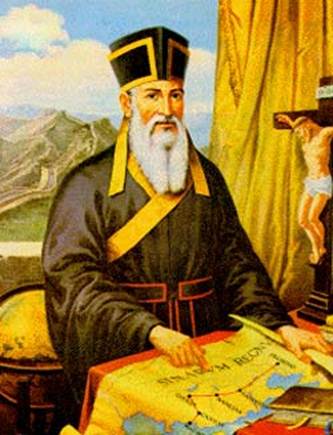


 تاريخ الرياضيات
تاريخ الرياضيات
 الرياضيات في الحضارات المختلفة
الرياضيات في الحضارات المختلفة 
 الرياضيات المتقطعة
الرياضيات المتقطعة
 الجبر
الجبر
 الهندسة
الهندسة 
 المعادلات التفاضلية و التكاملية
المعادلات التفاضلية و التكاملية 
 التحليل
التحليل
 علماء الرياضيات
علماء الرياضيات |
Read More
Date: 26-10-2015
Date: 13-1-2016
Date: 17-1-2016
|
Born: 6 October 1552 in Macerata, Papal States (now Italy)
Died: 11 May 1610 in Peking, China

After being educated at home by his parents, Matteo Ricci entered the Jesuit School in Macerata in 1561. He went to Rome in 1568 to study law but he was attracted to the Jesuit religious order which he joined in 1571. He then continued his studies in Rome, studying mathematics and astronomy under Clavius.
Ricci set out on his sea voyages in 1577. He arrived first in Portugal where he studied at the University of Coimbra for a while. Then, in 1578, he sailed to the Portuguese city of Goa on the west coast of India. In Goa Ricci studied for the priesthood, and he was ordained in 1580. Two years later he sailed to China.
Ricci arrived at Macau on the east coast of China in 1582. He settled in Chao-ch'ing, Kwangtung Province and began his study of Chinese. He also worked at acquiring understanding of Chinese culture. While there Ricci produced the first edition of his map of the world Great Map of Ten Thousand Countries which is a remarkable achievement showing China's geographical position in the world.
In 1589 Ricci moved to Shao-chou and began to teach Chinese scholars the mathematical ideas that he had learnt from his teacher Clavius. This is perhaps the first time that European mathematics and Chinese mathematics had interacted and it must be seen as an important event. Ricci attempted to visit Peking in 1595 but found the city closed to foreigners. He went instead to Nanking where he lived from 1599, working on mathematics, astronomy and geography.
Ricci was well received in Nanking and this encouraged him to try again to visit Peking which he did in 1601. This time he was allowed to live in the city and he made this his home from that time until his death nine years later.
There was at that time a problem with the European's understanding of whether the country which Marco Polo had visited by an overland route, and called Cathay, was the same country as China which had been visited by sea. Marco Polo, also an Italian, had travelled from Europe through Asia beginning his journey in 1271 and living in Cathay for 17 years before returning to Italy. Ricci was convinced that these countries were the same but, until another overland journey was made, this could not be confirmed. Ricci's hypothesis was proved by another Jesuit by the name of De Goes, who set out from India in 1602, and although he died in 1607 before reaching Peking, he had by that time made contact by letter with Ricci and proved that Marco Polo's Cathay was China.
By the time he was living in Peking, Ricci's skill at Chinese was sufficient to allow him to publish several books in Chinese. He wrote The Secure Treatise on God (1603), The Twenty-five Words (1605), The First Six Books of Euclid (1607), and The Ten Paradoxes (1608). The First Six Books of Euclid was based on Clavius's Latin version of Euclid's Elements which Ricci had studied under Clavius's guidance while in Rome. The Chinese reaction to Ricci's book, which showed them the logical construction in Euclid's Elements for the first time, is discussed in [10]. Certainly the style of Euclid was far from the style of Chinese mathematics and this mixing of mathematical cultures must have been a cultural shock to both sides.
Ricci of course had to dress in the style of a Chinese scholar and be known under a Chinese name, he used 'Li Matou', to become accepted by the Chinese. However he became famous in China for more than his mathematical skills, becoming known for his extraordinary memory and for his knowledge of astronomy. He even became known as a painter and a painting of a landscape around Peking has recently been attributed to him.
Books:
Articles:



|
|
|
|
لخفض ضغط الدم.. دراسة تحدد "تمارين مهمة"
|
|
|
|
|
|
|
طال انتظارها.. ميزة جديدة من "واتساب" تعزز الخصوصية
|
|
|
|
|
|
|
مشاتل الكفيل تزيّن مجمّع أبي الفضل العبّاس (عليه السلام) بالورد استعدادًا لحفل التخرج المركزي
|
|
|